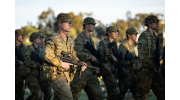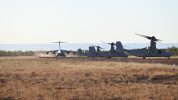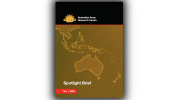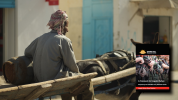Search
Using the filters to the left, click your selection, it will become bold and filter the results, click it again to remove that filter.
The Army Robotics Expo (ARX) 2022 is part of the Chief of Army Symposium (CAS) 2022 Expo Series. ARX 2022 and is an opportunity to observe and demonstrate Australian industry Robotic and Autonomous Systems (RAS) technologies and concepts which align to potential capability as identified within the Army RAS Strategy. ARX 2022 is open to CAS 2022 Exposition attendees on 11 August 2022, and will be open to all Army Futures Forum attendees at scheduled times on 11 August 2022. Visit the CAS 2022 site for more …

“To be prepared for war is one of the most effective means of preserving peace.” George Washington Introduction The government’s recent political announcement to expand the Australian Defence Force by 20,000 personnel is welcomed. To be a significant ‘land power’ deterrent, the Army will need the capability to expand numbers quickly with trained soldiers. Swiss history confirms the need for middle power nations to have a capable reserve force to mobilise in response to national security contingencies. The …

The Implications of the Precision Strike Revolution Introduction For several decades, the art of war has been in the midst of a revolution. The combination of pervasive sensors with long-range precision strike capabilities, that was first evident in the 1991 Gulf War, has spread globally. Once the Australian Army acquires HIMARS , it too will gain the ability to strike with precision and at distances which are currently beyond reach. Moreover, as the technology improves, the distance at which these weapons …

This Spotlight Brief provides an introduction and context to the ongoing Russo-Ukrainian War. It discusses Ukraine’s strategic circumstances and provides an overview of the chain of events which led to it. The Brief aims to provide a wide audience with a basis of knowledge to better understand the relationship between Russia and Ukraine and why the conflict occurred. … Spotlight Brief …

Signaller with NORFORCE from 2020, I am born and bred in Darwin, Northern Territory. My interests include offroading, camping, fishing, and hunting … Connor Cruickshank …

Four New Principles of War The Principles of War (POW) that we ascribe to have long been studied and advocated in military institutions. Based on the post-World War One work of Major General J F C Fuller CB, CBE, DSO, their importance as a foundation for the conduct of warfare has been reaffirmed over the years. Originally there were nine Principles, with the tenth being added subsequently (initially referred to as ‘Administration’, it is now known as ‘Sustainability’). The pace of technological advance …

The Strategic Circumstances of the Russo-Ukraine War Introduction As the origin of its name implies, ‘borderland’,1 Ukraine has long served as a buffer state between Eastern and Western Europe. Its history reflects the continued and often violent contest for its allegiance, if not ownership. Ukraine’s importance has been recently underscored by its invasion on 24 February 2022 by the Russian Armed Forces. This was a significant escalation of the conflict which commenced with Russia’s annexation of the …
LTCOL Bruce Cameron, MC, psc, qtc, aic, CGIA (retd), served in the Australian Regular Army for nineteen years. After commanding the last troop of tanks in action in Vietnam, he completed a number of regimental, staff and training assignments. His last appointment involved responsibility for helping develop Army's future ground mobility requirements. He left the Army in 1987 to take up a position with the Office of Defence Production. He is the author of 'Canister! On! Fire! : Australian Tank Operations in …
A Framework for Irregular Warfare Australia has a long history with insurgency and considers its experience in Phuoc Tuy, Vietnam and Uruzghan, Afghanistan, as examples evidencing a reputation as a world leader in this space. An innate capability for insurgency and irregular warfare would seem logical given the frequency of insurgency in our region; almost all South-East Asian nations have experienced insurgency since World War II. [1] Despite this context and recent operational experience in Iraq and …

A Strategic Plan for Tunisia Tunisia is challenged by a dual insurgency, with affiliates of al-Qaeda and ISIS exploiting grievances within the population and leveraging Islam to mobilise support. The objective of these affiliates is to discredit the Tunisian authorities and install a sharia-ruled government. [1] Tunisia’s strategic partnership with Algeria has moderately suppressed a cross-border insurgency in Tunisia’s west, although the insurgency still leads the contest for the control of the …


